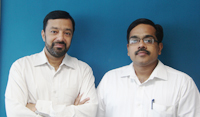October 2012: Mistral Solutions is a technology design and systems engineering company providing end-to-end solutions for product design and application deployment.
Narayanan Bhattathiripad, senior vice president (emerging business), and Krishnakumar M., vice president (product engineering services delivery), spoke to Ashwin Gopinath of EFY about the challenges in designing for the defence sector.

Q. How is designing for the defence sector different from designing for other sectors?
A. The emphasis on research is very high in the defence field and hence there is a lot of scope to innovate. Solutions provided for the defence organisations are all very hi-tech, both with respect to the hardware and the software. The solutions are superior not only in terms of reliability but also complexity. The defence market also relies hugely on the ruggedness of the product. When we deliver a product to the defence labs, we are expected to provide a warranty of 15 years. Hence, while working with the defence, we have to work with a host of strict parameters.
Q. How do you see the mixed-signal processing growing?
A. I would say that mixed-signal processing is a default, atleast in the consumer space. Everyday, we see wirelessly connected devices increasing exponentially and soon they will be the future default requirement on a device. When you have a market where wireless connectivity is a given, and different types of radios are present on the same device along with high-speed signals on the same PCB, it is vital to know mixed signals like the back of your hand.
Q. What’s happening on the consumer market front?
A. In the consumer market, we have consciously stayed away from working on high-volume production products like smartphones. We work on mostly specialised equipment with reasonably high complexity including (but not limited to) multimedia/audio-and-video compression. Our most exciting product is the head-mounted computer. The user mounts the device on his head like a head band. It has an LCD screen with SVGA resolution that comes up right in front of the user’s eyes, giving him the feel of a big screen in front of him.
The entire computing power of the system is located on the band and comes up at the back of the head. It was designed to assist in hands-free execution of tasks, primarily where the operator has to look up content and then proceed accordingly. It can be used on the factory floor or by a technician. The device will connect wirelessly to a central server and is completely voice-activated. It employs a highly directional microphone to make sure that it captures only user commands and ignores the background noise. It takes commands in English and the user can give normal voice commands like ‘next page,’ ‘previous page,’ ‘next directory’ and so on to activate the required functions. It can also handle multiple files at a time.
The computer also has a head tracker that can assist in browsing through pages. If you move your head to the right, the page shifts to the next page and so on. We see a huge market for this product across different applications.
Q. Like GPS, do you see any other technology from the defence side coming over to the consumer side?
A. That is the natural flow of technology. Ninety per cent of the breakthroughs in technology are financed and researched by the government. So it’s always just a matter of ‘when,’ not ‘if.’ Off the top of my head, I can think of autonomous automobiles crossing over into the public domain. It’s a relatively untested technology but the amount of study in this section by the government is huge. Another example would be food preservation. The government is researching food preservation techniques to store food more effectively in space. I think that too will find its way into the civilian
market sooner than later.
Q. Was there any technical challenge that stumped your design team?
A. Well, there was this one particularly big problem we had with power spikes on one of our boards. Since power spikes are common in many applications, every type of power spike is dealt with in its own way. The one we came across was affecting our battery-operated device adversely. Whenever the board was switched on, it produced a spike.
Usually, the manufacturers put in place a safety provision to prevent such spikes from producing undesirable effects. But this project was actually a specialised one and the application-specific integrated circuit (ASIC) we were using wasn’t the least bit tolerant to power spikes. These spikes also lasted longer than most spikes (from microseconds to very close to half a second). We realised that some of the ASICs we used were susceptible to the power spikes and hence we had to find a way to suppress them before something drastic happened.









Looking for a simple optical circuit to use on a model race car finish detector